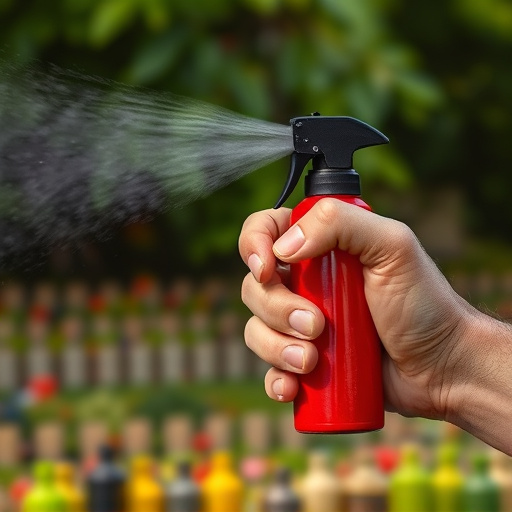The best first aid for pepper spray exposure involves immediate actions like flushing eyes with water (15 mins), seeking fresh air, and applying cold compresses. Key to managing symptoms is understanding capsaicin, the active ingredient. When choosing a defense aerosol, consider range, strength, duration, reliability, and clear labeling. Proper training enhances effectiveness. Aim directly at face/eyes, use quick bursts, and practice accuracy. In case of exposure, move to safety, remove contaminated clothes, and irrigate eyes & skin with water. Store aerosols securely out of reach.
Aerosol spray defense has emerged as a powerful tool for personal safety, offering a quick and effective deterrent against attackers. This comprehensive guide delves into the world of pepper spray, exploring its active ingredients and immediate effects. We’ll navigate the market to find the best aerosol spray options tailored for self-defense. Learn essential application techniques and understand legal considerations to ensure safe and responsible use, making it an invaluable first aid for pepper spray situations.
- Understanding Pepper Spray: Active Ingredients and Effects
- Choosing the Best Aerosol Spray for Personal Defense
- Effective Application Techniques to Deter Attackers
- Legal Considerations and Safety Precautions When Using Aerosol Spray
Understanding Pepper Spray: Active Ingredients and Effects
Pepper spray, a popular defense mechanism, is designed to incapacitate an attacker temporarily through targeted irritation of the eyes and respiratory system. The primary active ingredient in most pepper sprays is capsaicin, a compound derived from chili peppers. When deployed, capsaicin causes intense burning sensations, leading to temporary blindness and difficulty breathing for the target. This disruption enables users to escape or seek assistance.
Choosing the best first aid for pepper spray exposure involves understanding its effects and having immediate access to soothing and restorative measures. The best first-aid practices include flushing the eyes with clean water for at least 15 minutes to irrigate the capsaicin, seeking fresh air to ease respiratory distress, and applying cold compresses to reduce swelling and pain. Additionally, neutralizing agents or specific decontaminants recommended by manufacturers can further alleviate discomfort.
Choosing the Best Aerosol Spray for Personal Defense
When selecting an aerosol spray for personal defense, understanding your specific needs is key. Consider factors like range, strength, and duration of the spray, as well as the type of attacker you might face. For instance, a longer-range spray can provide distance and safety, while higher concentration levels offer greater stop-power against larger or more determined aggressors.
In terms of the best first aid for pepper spray, opt for a product that combines these essential elements. Look for sprays with a reputation for reliability and consistent effectiveness. Additionally, ensure the aerosol has a clear labeling system so you know exactly what you’re using, especially if it’s your first time carrying such a device. Remember, proper training in its use is also crucial to guarantee its effectiveness during an emergency situation.
Effective Application Techniques to Deter Attackers
To maximize the effectiveness of aerosol spray as a defense against attackers, proper application techniques are crucial. Aiming directly at the face and eyes is key; pepper spray irritates sensitive areas, temporarily disabling the attacker. Hold the canister at close range, about 2-3 feet away, and sweep the nozzle back and forth to ensure a wide area is covered. This method prevents any chance of missing your target and allows for maximum impact.
Additionally, practicing quick and controlled releases is vital. Release the spray in short bursts rather than continuous streams, as this can reduce wind resistance and improve accuracy. The best first aid for pepper spray involves immediate flushing of the eyes with water and seeking fresh air. Those affected should remove any clothing that comes into contact with the spray to minimize exposure and discomfort.
Legal Considerations and Safety Precautions When Using Aerosol Spray
When considering aerosol spray as a defense mechanism, it’s crucial to understand the legal implications and safety protocols involved. Each jurisdiction has specific laws governing the possession and use of pepper spray or other aerosol defensive agents. Using them for self-defense can have legal consequences, so staying informed about local regulations is essential.
Safety precautions are paramount when handling aerosol spray. Users must receive proper training to ensure they understand the spray’s range, effectiveness, and potential side effects, especially on bystanders. The best first aid for pepper spray exposure involves promptly moving to a safe distance, removing contaminated clothing, and irrigating the eyes and skin with water. Always store aerosol sprays securely, out of reach of children and unauthorized individuals, to prevent accidental use or misuse.
Aerosol spray, a powerful personal defense tool, can be an effective first aid solution against attackers. By understanding its active ingredients, choosing the right product, and mastering application techniques, individuals can better protect themselves in potentially dangerous situations. However, it’s crucial to navigate legal considerations and safety precautions, as responsible use is essential. The best first aid for pepper spray involves both knowledge and caution, ensuring personal safety while adhering to local regulations.
